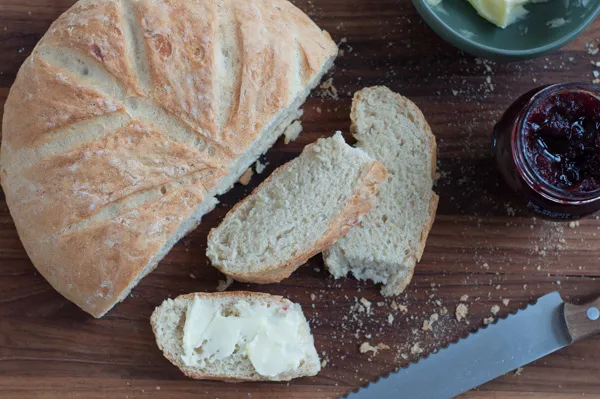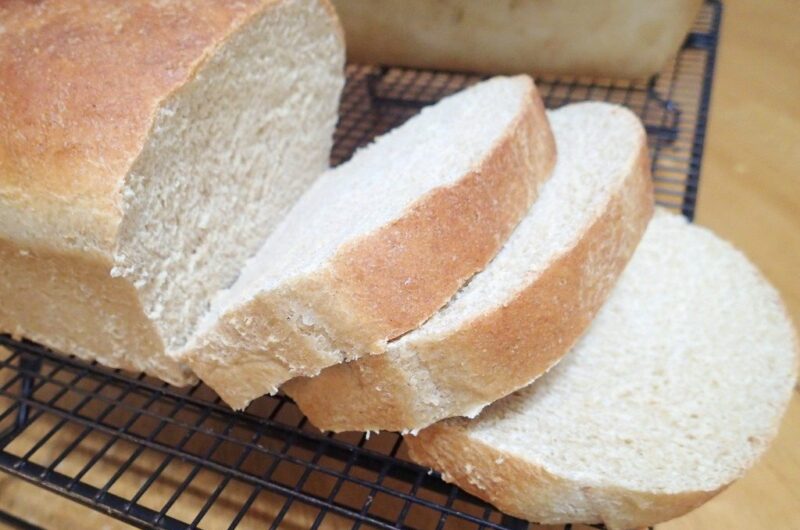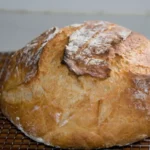Imagine standing on the summit of a majestic mountain, surrounded by breathtaking views and a crisp, invigorating breeze. Just as your eyes feast upon the beauty of the landscape, your nose catches a whiff of something equally enticing – the aroma of freshly baked bread wafting through the thin air.
It’s a scene that evokes a sense of wonder and curiosity, leaving you eager to discover the secrets of creating the perfect loaf at high altitudes. Well, my friend, you’re in luck. In this discussion, we will unravel the mysteries of high altitude bread baking, exploring essential ingredients, techniques, and tips that will have you achieving fluffy, delicious loaves that defy the challenges of elevation.
Get ready to embark on a culinary journey like no other.
Contents
- 1 Key Takeaways
- 2 Understanding High Altitude Baking
- 3 Essential Ingredients for High Altitude Bread
- 4 Adjusting Yeast and Leavening Agents for Altitude
- 5 Mixing and Kneading Techniques for High Altitude Bread
- 6 Baking Tips for Perfectly Fluffy Loaves at Altitude
- 7 High Altitude Bread Recipe
- 8 Delicious Variations of High Altitude Bread Recipes
- 9 Frequently Asked Questions
- 9.1 Can I Use All-Purpose Flour Instead of Bread Flour in High Altitude Bread Recipes?
- 9.2 How Can I Prevent My High Altitude Bread From Collapsing in the Middle?
- 9.3 Can I Use Instant Yeast Instead of Active Dry Yeast in High Altitude Bread Recipes?
- 9.4 What Adjustments Should I Make to the Baking Time and Temperature for High Altitude Bread?
- 9.5 Can I Substitute Whole Wheat Flour for Part of the All-Purpose Flour in High Altitude Bread Recipes?
- 10 Conclusion-High Altitude Bread Recipe
Key Takeaways
- Adjusting recipes for high altitude baking can help counteract challenges such as collapsed cakes and dry breads.
- Using bread flour or all-purpose flour with higher protein content can enhance gluten development and structure in high altitude bread.
- Reducing yeast amount and adjusting rising times can prevent over-rising and collapsing of the dough.
- Proper mixing and kneading techniques, along with experimenting with different yeast quantities and rising times, can result in a well-textured loaf at high altitudes.
Understanding High Altitude Baking
To successfully navigate high altitude baking, it’s essential to understand the unique challenges and adjustments required for achieving optimal results. Baking at high altitudes poses several challenges due to the lower atmospheric pressure and reduced oxygen levels. These factors affect the behavior of ingredients and can lead to undesirable outcomes such as collapsed cakes, dry breads, and unevenly risen pastries. However, armed with the right knowledge and techniques, you can overcome these challenges and create delicious baked goods at high altitudes.
One of the main challenges of high altitude baking is the tendency for baked goods to rise too quickly and then collapse. This is because the reduced air pressure allows gases to expand more rapidly, causing the structure of the baked goods to weaken and collapse before it has a chance to set. To counteract this, it’s important to make adjustments to your recipes, such as reducing the leavening agents and increasing the liquid content. Additionally, using a lower oven temperature and extending the baking time can help create a more stable structure.
Another challenge is the tendency for baked goods to become dry at high altitudes. This is because the lower air pressure leads to faster evaporation of moisture during baking. To combat this, you can increase the amount of liquid in your recipes, whether it be water, milk, or other liquids. Adding extra fat, such as butter or oil, can also help retain moisture and improve the texture of your baked goods.
Essential Ingredients for High Altitude Bread
Using the right ingredients is crucial for achieving optimal results when baking bread at high altitudes. When it comes to flour types, it’s recommended to use bread flour or all-purpose flour for high altitude bread recipes. These flours have a higher protein content, which helps with gluten development and provides structure to the bread. Additionally, using a combination of whole wheat flour and bread flour can enhance the flavor and texture of the bread.
In terms of rising time, it’s important to understand that bread dough rises faster at higher altitudes due to the lower air pressure. To counteract this, it’s advisable to reduce the amount of yeast used in the recipe. This will slow down the rising process and allow the dough to develop a better flavor and texture. It’s also recommended to let the dough rise in a slightly warmer environment, as the cooler temperatures at higher altitudes can slow down fermentation.
Adjusting Yeast and Leavening Agents for Altitude
Adjusting yeast and leavening agents for high altitude baking requires careful consideration of the unique environmental conditions that affect the fermentation process.
At higher altitudes, the air pressure is lower, which means that the gases produced by yeast during fermentation expand more rapidly. This can lead to over-rising and collapsing of the dough. To adjust for this, you can reduce the amount of yeast used in the recipe. Start by cutting the yeast by about 25% and observe the rising time. If the dough still rises too quickly, reduce the yeast further. On the other hand, if the dough doesn’t rise sufficiently, you may need to increase the amount of yeast.
It’s important to note that adjusting rising times is crucial at high altitudes as the dough may rise faster than usual. Keep a close eye on the dough during the rising process to prevent it from over-rising or collapsing.
Troubleshooting common issues that arise during high altitude baking involves experimenting with different yeast quantities and rising times to find the right balance. By making these adjustments, you can ensure that your bread rises properly and produces a delicious, well-textured loaf.
Mixing and Kneading Techniques for High Altitude Bread
When considering the unique environmental conditions at high altitudes, such as lower air pressure and rapid gas expansion during fermentation, it’s essential to employ specific mixing and kneading techniques for high altitude bread. These techniques will help achieve optimal results and prevent common issues encountered when baking bread at higher elevations.
One important aspect to consider is the mixing time. Due to the lower air pressure, it’s recommended to extend the mixing time slightly compared to sea level recipes. This will ensure proper gluten development and a more uniform dough structure. Keep in mind that overmixing can lead to a denser texture, so it’s crucial to strike a balance.
Another key technique is the kneading process. High altitude bread requires more kneading than traditional recipes to promote gluten formation and strengthen the dough. Aim for around 10-15 minutes of kneading, or until the dough reaches a smooth and elastic consistency. This will help the bread rise properly and achieve a desirable texture.
When troubleshooting high altitude bread, it’s important to consider the type of flour being used. Some brands, such as King Arthur Flour or Bob’s Red Mill, are specifically formulated for high altitude baking. These flours have a higher protein content, which aids in gluten development and provides better structure to the bread.
Baking Tips for Perfectly Fluffy Loaves at Altitude
For perfectly fluffy loaves at altitude, employ these baking tips to ensure optimal results. High altitude bread baking can present some challenges, but with the right techniques, you can achieve delicious and fluffy loaves every time.
One key tip is to adjust the yeast amount. At higher altitudes, the air pressure is lower, which means yeast will rise more quickly. To prevent overproofing, reduce the amount of yeast by about 25%.
Additionally, you may need to increase the liquid content in your dough. The lower air pressure can cause the dough to dry out faster, so adding a little more liquid can help maintain moisture and prevent dry bread.
Another important tip is to increase the baking temperature. At higher altitudes, water boils at a lower temperature, which can affect the baking process. By increasing the temperature by about 25 degrees Fahrenheit, you can ensure that the bread bakes properly and reaches the desired internal temperature.
Lastly, when it comes to storing high altitude bread, it’s best to keep it in a cool and dry place. Moisture can cause the bread to become stale or moldy more quickly, so wrapping it in a clean kitchen towel or storing it in an airtight container will help maintain its freshness.
High Altitude Bread Recipe
Course: BakingCuisine: AnyDifficulty: Intermediate12
servings15
minutes1
hour150
kcalExperience airy, fluffy bread at high altitudes with this recipe. Perfectly balanced ingredients and precise techniques yield delicious results, making it a staple for elevated environments.
Ingredients
3 cups all-purpose flour
1 packet active dry yeast
1 tablespoon sugar
1 teaspoon salt
1 cup warm water
2 tablespoons olive oil
Directions
- In a large bowl, combine flour, yeast, sugar, and salt.
- Gradually add warm water and olive oil, stirring until a dough forms.
- Knead the dough on a floured surface until smooth and elastic.
- Place dough in a greased bowl, cover, and let rise in a warm place until doubled in size.
- Punch down the dough and shape it into a loaf.
- Place the dough in a greased loaf pan, cover, and let rise again until doubled.
- Preheat oven to 375°F (190°C).
- Bake bread for 30-40 minutes until golden brown and sounds hollow when tapped.
- Let cool before slicing and serving. Enjoy your homemade high altitude bread!
Delicious Variations of High Altitude Bread Recipes
To create a delicious variation of high altitude bread recipes, consider incorporating unique ingredients or flavors that will elevate the taste and texture of your loaves. By adding flavorful additions and exploring gluten-free options, you can create bread that’s both delicious and suitable for those with dietary restrictions.
Here are some ideas to inspire you:
- Flavorful Additions:
- Herbs and Spices: Experiment with adding herbs like rosemary, thyme, or basil, or spices like cinnamon or nutmeg to your bread dough. These additions will infuse your bread with aromatic flavors.
- Cheese: Incorporate shredded cheese, such as cheddar or parmesan, into your dough for a savory twist. The melted cheese will create pockets of gooey goodness throughout the loaf.
- Gluten-Free Options:
- Alternative Flours: Replace traditional wheat flour with gluten-free alternatives like almond flour, rice flour, or chickpea flour. These flours will provide a unique taste and texture to your bread.
- Seeds and Nuts: Add a crunchy element to your bread by including a mix of seeds and nuts, such as sunflower seeds, flaxseeds, or chopped almonds. These ingredients won’t only enhance the flavor but also provide added nutritional value.
Frequently Asked Questions
Can I Use All-Purpose Flour Instead of Bread Flour in High Altitude Bread Recipes?
You can use all-purpose flour instead of bread flour in high altitude bread recipes. However, keep in mind that bread flour has a higher protein content, which helps with gluten development. Experiment and adjust as needed.
How Can I Prevent My High Altitude Bread From Collapsing in the Middle?
To prevent your high altitude bread from collapsing in the middle, ensure that you accurately measure your ingredients and follow the recipe instructions precisely. Troubleshoot issues like overproofing or underbaking to achieve the perfect loaf.
Can I Use Instant Yeast Instead of Active Dry Yeast in High Altitude Bread Recipes?
You can substitute instant yeast for active dry yeast in high altitude bread recipes. However, keep in mind that instant yeast may rise faster, so adjust rising times accordingly. Follow these tips for successful high altitude bread baking.
What Adjustments Should I Make to the Baking Time and Temperature for High Altitude Bread?
To adjust the baking time and temperature for high altitude bread, you need to increase the temperature by 15-25 degrees Fahrenheit and decrease the baking time by 5-10 minutes. This ensures proper baking without over-drying the bread.
Can I Substitute Whole Wheat Flour for Part of the All-Purpose Flour in High Altitude Bread Recipes?
You can substitute whole wheat flour for part of the all-purpose flour in high altitude bread recipes. However, be aware that this may require adjusting the rising time to ensure proper texture and rise.
Conclusion-High Altitude Bread Recipe
In conclusion, mastering the art of high altitude bread baking requires a thorough understanding of the unique challenges and adjustments necessary at higher elevations.
By carefully selecting the essential ingredients, adjusting yeast and leavening agents, and employing proper mixing and kneading techniques, you can achieve perfectly fluffy loaves that will tantalize your taste buds.
With these delicious variations of high altitude bread recipes, you can explore a world of flavors and textures that will elevate your baking to new heights.




